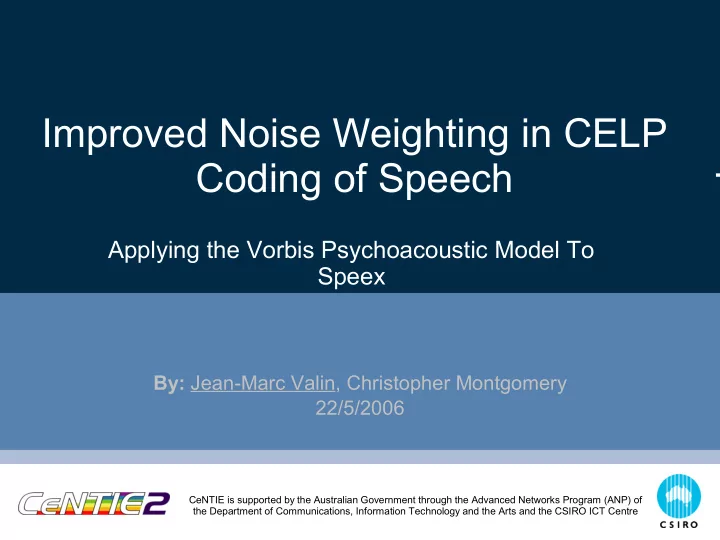

Improved Noise Weighting in CELP Coding of Speech T T Applying the Vorbis Psychoacoustic Model To Speex By: Jean-Marc Valin, Christopher Montgomery 22/5/2006 CeNTIE is supported by the Australian Government through the Advanced Networks Program (ANP) of the Department of Communications, Information Technology and the Arts and the CSIRO ICT Centre
Introduction www.ict.csiro.au Goal: Improve perceptual weighting of the noise in an existing CELP codec (Speex) Proposed solution: adapt and apply the Vorbis psychoacoustic model to the Speex codec Outline Overview of Speex Overview of Vorbis and psychoacoustic model Application to Speex Evaluation & results Complexity Conclusion
Overview of Speex www.ict.csiro.au Speech codec based on CELP Sampling rates, bitrates: Narrowband (8 kHz): 2.15 kbps to 24.6 kbps Wideband (16 kHz): 3.95 kbps to 42.2 kbps Features: Open-source (BSD-licensed): http://www.speex.org/ Source-controlled variable bitrate (VBR) Embedded wideband coding Variable encoder complexity Optimised for VoIP Bit-stream finalized in March 2003
Speex Encoder Structure www.ict.csiro.au CELP variant with 20 ms frames (5 ms sub-frames) No inter-frame coding other than LPC and pitch prediction 3-tap pitch predictor Sub-vector quantization of innovation “Global” excitation gain Default noise weighting is LPC-derived W z = A z / 1 A z / 2 , 1 = 0.9, 2 = 0.6
Vorbis Psychoacoustic Model www.ict.csiro.au Vorbis is an open-source, MDCT-based audio codec Psychoacoustic model shapes noise according to: Tone masking Noise masking Noise normalization Impulse analysis Noise shaping approximates the masking threshold Good for transparent audio Bad for lossy speech
Application to Noise Weighting in Speex www.ict.csiro.au Vorbis “floor” curve interpreted as the inverse of the optimal perceptual weighting filter Amplitude companding required Compute curve for each frame and interpolate on sub-frames W z = W n z 1 Convert to pole-zero model: W d z Denominator: • Curve to auto-correlation (IFFT) • Auto-correlation to LPC (Levinson-Durbin) Numerator: • Remove denominator contribution (1/FFT of denominator) • Convert inverse to LPC (IFFT and Levinson-Durbin)
Curves www.ict.csiro.au
Evaluation www.ict.csiro.au Objective listening quality: PESQ MOS-LQ0 (P.862.x) Tested on NTT multilingual speech database 354 files 177 speakers 20 languages Reference: Speex version 1.2-beta1 (pre-release)
Results (narrowband) www.ict.csiro.au
Results (wideband) www.ict.csiro.au
Complexity Reduction www.ict.csiro.au Three strategies: 1 1 1) Use all-pole model W z = W d z 2) Force W d z = A z W z 1 Synthesis+weighting filter simplifies to A z = W n z Reduces complexity of the filtering 3) Apply 2) and make constant for a whole frame W n z Only one conversion per frame None of 1), 2) or 3) causes significant degradation
Conclusion www.ict.csiro.au Proposed an improved noise weighting for the Speex codec Noise weighting is based on the Vorbis psychoacoustic model Up to 20% (equivalent) improvement at high bitrate Little or no improvement at low bitrate A case for more research to be done in noise weighting for CELP A subjective MOS test is desirable Future work Investigate efficient approximations for W n z Derive CELP-specific masking models
Questions? www.ict.csiro.au
Recommend
More recommend